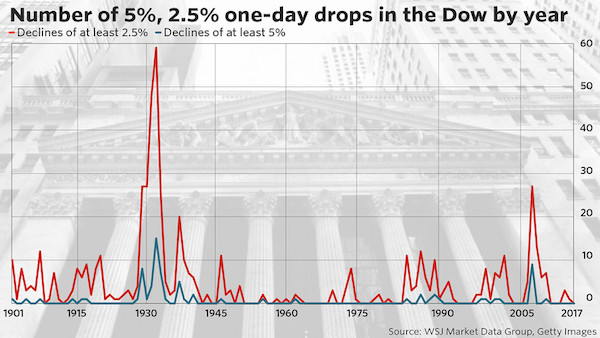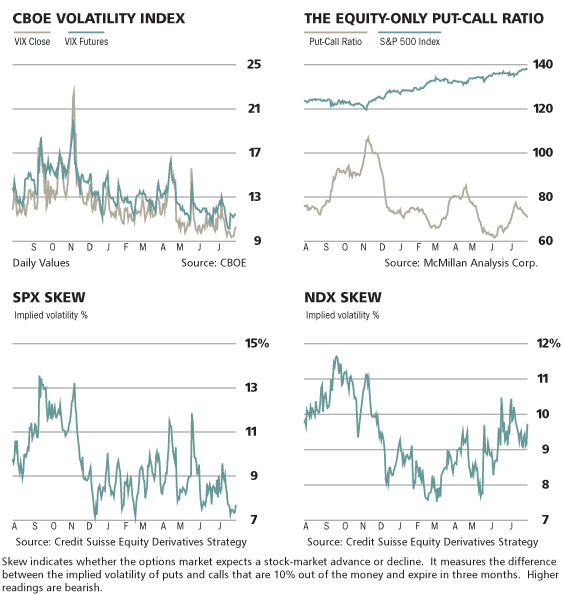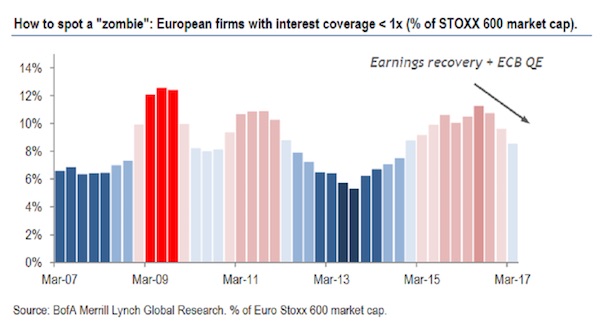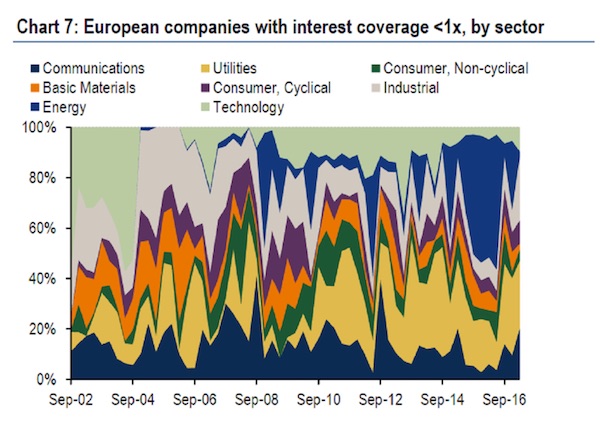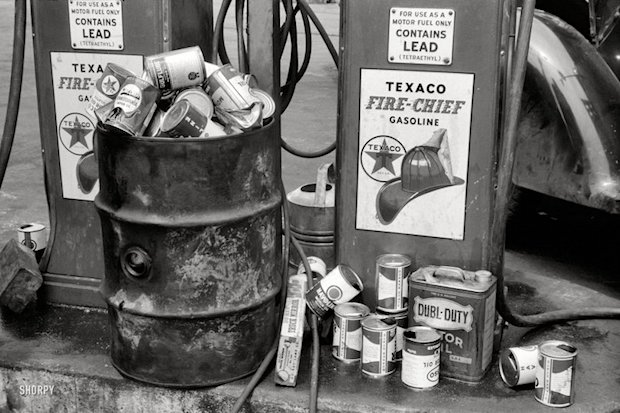
Jack Delano Discarded oil cans at truck service station on U.S. 1, New York Avenue, Washington, DC 1940

Well, we do have some numbers:
• Cases 71,330, up 2,076 from yesterday
• Deaths 1,775, up 106 from yesterday
• 760 million Chinese under quarantine
We also have plenty confusion. For instance, Reuters has two headlines that say Coronavirus Cases Rise Again In China and China Says New Cases Slow. That clears things up.
But the most dramatic event over the weekend must be the repatration of various nationalities to their homelands. About 400 Americans were evacuated from the Diamond Princess, with Australian Canadian, Italian, South Korean and Hong Kong passengers set to follow soon. 44 of these Americans are infected with the virus, and they won’t be going home. The rest will, though.
This is happening while “Japan is bracing for the possibility of hundreds of additional cases of the coronavirus onboard the stricken Princess Diamond”, says the Guardian. So the Americans that are flown home go into quarantine, right? Well… “Some Diamond Princess passengers face another two weeks in isolation if they have shared a cabin with someone who tests positive.”
Remember, as of the start of the evacuation, there were 3,711 people on board. 1,219 had been tested of which 355 have been confirmed positive for the virus (among them the 44 Americans). Ergo, 2,492 people were not tested, among them the remaining 356 Americans. Who will only go into isolation if they shared a cabin with a positive case. The rest can do what they want.
We see the issue here, don’t we? How many of those 356 Americans may be infected? How many of the other nationalities which will fly home? There have been suggestions that the onboard air circulation system on the ship may have played a role in spreading the virus. If so, it could be everywhere. And yes, there could be “hundreds of additional cases”.
Then there’s the Werkendam cruise ship, from which hundreds were allowed to spread all over the world, taking off from Cambodia and/or Malaysia, before a positive case was found. Now it’s a “Scramble To Track Cambodia Cruise Ship Passengers”. Sort of like a modern version of the biblical “Go Forth and Multiply”. Where were these decisions made? Anyone ask the WHO, or China?
Meanwhile, China keeps trying. In Hubei province, Xiaogan city – with a population of nearly 5 million people, 3,279 confirmed cases of Covid-19, the second highest number in China, and 70 deaths, “all vehicles including motorcycles, electric bikes, bicycles and tricycles are prohibited from driving on the road”. Try that in NYC, LA, Paris, Moscow, name a major city.
And the economic effects get increased attention as well. “Barclays analysts estimate that real [Japan] GDP contracted 3.2% on a quarterly basis, a little better than market consensus of -3.8%. This is all pre-coronavirus…] Take it from there. At this point hearing from economists, bankers, investors is pretty useless, because they have little idea what goes on, and, like politicians, they won’t consider really bad scenarios until it’s too late.
But it’ll come trickling through. Served in a sauce of “we’ll be fine”.
UPDATE: 99 additional people tested positive aboard the Diamond Princess. 14 American evacuees who tested positive made the flight anyway, in a separate compartment
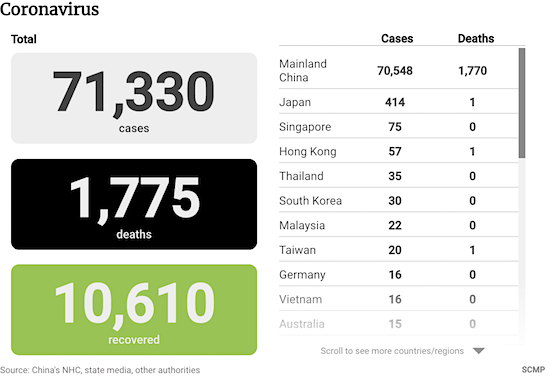

“Xiaogan, 70km from the city of Wuhan, has 3,279 confirmed cases of Covid-19, and has recorded 70 deaths.”
• Japan Braces For Hundreds More Cases Onboard Cruise Ship (G.)
Japan is bracing for the possibility of hundreds of additional cases of the coronavirus onboard the stricken Princess Diamond, as experts warned the country was still in the “early stages” of the outbreak. The passengers evacuated from the ship face further uncertainty too, with the US and Australian citizens set for a further two weeks of quarantine after arriving homeHundreds of American passengers have flown back to the US and Australia said it would follow suit on Wednesday. Onboard the Diamond Princess, 355 people have been diagnosed with Covid-19 out of an original total of about 3,600 passengers and crew, and after testing 1,219. Forty American passengers who were diagnosed with the virus have been transferred to hospitals in Japan.
Some Diamond Princess passengers face another two weeks in isolation if they have shared a cabin with someone who tests positive. The total number of people infected around the world climbed to more than 71,000 on Monday, including a further 2,048 confirmed cases in China, where the total number of deaths stands at 1,770. Five people have died outside China. Of the 105 deaths reported in China on Monday, 100 were in Hubei province, the centre of the outbreak. Cities in Hubei have stepped up measures to stop the virus’s spread.
Xiaogan city – which has a population of nearly 5 million people and the second highest number of confirmed cases in China – ordered residents to stay in their homes or face detention of up to 10 days. State media reported that “all vehicles including motorcycles, electric bikes, bicycles and tricycles are prohibited from driving on the road”. Xiaogan, 70km from the city of Wuhan, has 3,279 confirmed cases of Covid-19, and has recorded 70 deaths.

Fifth location outside China.
• Taiwan Confirms First Coronavirus Death On Island, Cases At 20 (R.)
A taxi driver has died from the coronavirus in Taiwan, marking the first such death on the island and the fifth fatality outside mainland China from an epidemic that has curbed travel and disrupted global supply chains. Health Minister Chen Shih-chung said during a news conference on Sunday that the deceased person was a 61-year-old man who had diabetes and hepatitis B. Taiwan has to date accumulated 20 confirmed cases. The deceased person had not traveled abroad recently and was a taxi driver whose clients were mainly from Hong Kong, Macau and mainland China, the minister said. One of his family members was also confirmed to have the virus.
The pair constituted Taiwan’s first local transmission cases, the minister said, adding that authorities were trying to find out as soon as possible the source of contraction. “So far, we are not able to gather his contact history, so we are actively making investigations, hoping to find out the source of the contraction,” Chen said. The island will on Monday start testing all patients who show symptoms associated with coronavirus and had traveled abroad recently, the health ministry said.
The coronavirus, thought to have emerged at a wildlife market in the central Chinese province of Hubei, has killed 1,665 people in China with latest figures showing 68,500 cases of the illness. Taiwan has banned entry to Chinese visitors and foreigners with a recent history of travel to China and suspended most flights to its giant neighbor. Many schools have also extended their Lunar New Year holiday to late February to curb the spread of the virus. In a response to panic buying of masks on the island, the government scrambled to build several mask production lines and Premier Su Tseng-chang has vowed to more than double its daily mask production to 10 million by early March.

Economic consequences. Japan was doing awful under Abenomics already.
• Pay Attention To Shanghai, Beijing, Japan Infection Rates (F.)
Beijing and Shanghai have under 1,000 reported cases and only four deaths, based on data compiled by Johns Hopkins University. Their data is sourced from the World Health Organization, the U.S. Center for Disease Control, the European Center for Disease Control and two China health agencies. China is the main source of the numbers. There are many people outside of China who doubt Beijing and Shanghai’s low case load. Watch for those numbers to rise in the weeks ahead. [..]
Covid-19 remains a mystery pathogen. It can be deadly. It’s like a bad pneumonia. Scientists believe it came from a species of bat. There is also concern that it escaped a virology research lab in Wuhan. There is no vaccine for Covid-19 yet, so those who have it are being treated with a variety of anti-viral medications and have to wait for the virus to work its way out of the body. Markets are repricing everything China related. Barclays Capital analysts released a 20-page report on the coronavirus on Friday where they said they were pushing out the recovery period, and think Japan heads into a technical recession because of it. Japan will release its fourth quarter GDP numbers on Monday.
Barclays analysts led by Tetsufumi Yamakawa in Tokyo estimate that real GDP contracted 3.2% on a quarterly basis, a little better than market consensus of -3.8%. This is all pre-coronavirus and mostly due to domestic tax matters. Yamakawa does see an increasing risk in first quarter weakness due to the Covid-19 impacts, and if that leads to negative growth, and it could, Japan hits a technical recession with back to back contraction. Weaker China tourism and a decrease in trade with China is a huge headwind for Japan. For Barclays, the probability of a recession there has surged to 69%.
Barclays’ China view is basically Wall Street consensus: so long as the virus stays concentrated in Hubei, they are going to trust China keeps it that way. [..] Xi Jinping last week called for even tighter restrictions on Hubei, and put two new Party bosses in charge to make sure the clampdown is enforced. “We think these efforts showed the urgency and determination of the government to stabilize the epicenter as soon as possible,” says Eric Zhu, an economist with Barclays in Hong Kong. “We expect incremental improvements,” he says.

How is Abe still the PM there?
• Japan’s Economy Shrinks At Fastest Rate Since 2014 (BBC)
Japan’s economy shrank at the fastest rate in five years at the end of 2019 as it was hit by a sales tax rise, a major typhoon and weak global demand. Annualised GDP fell by a much steeper than expected 6.3% in October-December. There are also concerns the coronavirus outbreak will mean the slump continues this quarter. That has raised fears that the world’s third-biggest economy may fall into recession. During the period Japanese consumer spending fell 2.9% after the country’s sales tax was raised in October to 10% from 8%. In the same month Typhoon Hagibis hit large parts of the country.
Last quarter, capital spending dropped by 3.7% and exports slipped 0.1% amid the ongoing US-China trade war. Investors are now watching to see whether the economy will rebound after the coronavirus forced China to shut down factories and led to a big drop in Chinese tourists visiting Japan. In response to today’s data economy minister Yasutoshi Nishimura said the Japanese government was ready to take all necessary steps to deal with the impact of the coronavirus outbreak on the economy and tourism.

Recession looms everywhere by now. We just don’t want to know it.
• Coronavirus Cases Rise Again In China, Recession Looms In Japan, Singapore (R.)
Japan and Singapore appeared to be on the brink of recession on Monday as the coronavirus epidemic disrupted tourism and supply chains around the world, and as China imposed tougher restrictions to try and stop the virus spreading further. The number of reported new cases of coronavirus in China’s Hubei province, the epicenter of the epidemic, rose on Monday by more than 1,933, after two days of falls, and there were 100 deaths reported since Sunday. Across mainland China, officials said the total number of cases rose by 2,048 to 70,548, with 1,770 deaths. Nearly 90% of new cases were in Wuhan, a city of 11 million people where the virus is believed to have originated at a market illegally trading wildlife late last year.
The virus, which is believed to have a 14-day incubation period, has forced thousands of people to be quarantined around the world. In Cambodia, authorities were scrambling to track down hundreds of passengers who disembarked from the Holland America Line cruise ship Westerdam after an American woman left the ship and was tested positive for coronavirus in Malaysia. More than 100 have already left the country, while some 300 are reportedly still in Cambodia. “I believe there’s 300 Americans here at this hotel plus a few hundred from other countries. We will all be tested for the coronavirus today and tomorrow by the Cambodian Ministry of Health,” said passenger Holley Rauen, a public health nurse and midwife from Fort Myers, Florida.
“We have no idea when we get to get home…” American passengers were taken off another cruise liner on Sunday to fly home after being quarantined for two weeks off Japan. Seventy new coronavirus cases were confirmed on board the Carnival Corp. Diamond Princess in Yokohama. The 3,700 passengers and crew have been held since Feb. 3. Some 355 people on board have tested positive for the disease, by far the largest cluster of cases outside China. Those with the disease have been taken to hospital in Japan and no one from the ship has died. Around half of the guests onboard are from Japan.

It’s just a matter of waiting for new clusters to pop up now.
• Americans Disembark From Virus-Hit Cruise; China Says New Cases Slow (R.)
American passengers were taken off a cruise liner on Sunday to fly home after being quarantined for two weeks off Japan, while China said the rate of new coronavirus cases had slowed, calling that proof its steps to fight the outbreak were working. An announcement aboard the Diamond Princess, where 3,700 passengers and crew have been held since Feb. 3, told Americans to get ready to disembark on Sunday evening for charter flights home. Passengers wearing masks could later be seen waving through the windows of buses parked near the ship. Of the roughly 400 Americans on the cruise, more than 40 are infected with the virus and will stay in Japan for treatment, said Dr. Anthony Fauci, director of the U.S. National Institute on Allergy and Infectious Diseases (NIAID).
“They are not going to go anywhere. They’re going to be in hospitals in Japan,” Fauci told the CBS News program “Face the Nation.” “People who have symptoms will not be able to get on the evacuation plane. Others are going to be evacuated starting imminently to air force bases in the United States.” Kyodo News Agency said the flights carrying U.S. passengers left Haneda Airport at around 1700 ET (2200 GMT). Canadian, Italian, South Korean and Hong Kong passengers were expected to follow soon, after their governments also announced plans to repatriate passengers. “Leaving in a few hours. No details. Might be going to Texas or Nebraska,” U.S. passenger Gay Courter told Reuters.
Seventy new coronavirus cases were confirmed on board, bringing the total on the ship to 355, by far the largest cluster of cases outside China. Fauci told the Washington Post there were 44 infected Americans. Within China, authorities reported 2,009 new cases on Sunday, noting that this was down from more than 2,600 the previous day. They said this showed their efforts to halt the spread of the virus were bearing fruit.

Is anyone criminally responsible?
• Scramble To Track Cambodia Cruise Ship Passengers After Virus Case Found (R.)
Holland America Line said it is working with governments and health experts to track passengers who disembarked from its Westerdam cruise ship docked in Cambodia after an American woman tested positive for coronavirus in Malaysia. The cruise line, which is owned by cruise giant Carnival Corp, said none of the other 1,454 passengers and 802 crew have reported any symptoms. “Guests who have already returned home will be contacted by their local health department and be provided further information,” a statement from the company said. Passengers had been cleared to travel by Cambodian authorities after health checks when the cruise ship docked on Thursday. It had spent two weeks at sea after being turned away by Japan, Taiwan, Guam, the Philippines and Thailand.
But on Saturday, Malaysia said an American woman who arrived in Kuala Lumpur on Friday on a chartered flight had tested positive for the new coronavirus that has killed more than 1,700 people, the vast majority in China. The woman’s husband tested negative for the coronavirus. About 137 of the 145 passengers on the chartered flight had already left for other countries as of Sunday after showing no signs of illness, Malaysian authorities said. Dozens more of the Westerdam passengers had flown through Thailand and onward to other countries, Thai officials said. At least 236 passengers and 747 crew remain aboard the vessel off the Cambodian port city of Sihanoukville, Holland America said. Others were in hotels in Phnom Penh, the capital.

Did you know the Chinese see the world the same way Christian religions do? G-d appointed man the master of the world! Must be the dumbest facet of religion: man declares himself G-d.
• ‘Animals Live For Man’: China’s Appetite For Wildlife To Survive Virus (R.)
For the past two weeks China’s police have been raiding houses, restaurants and makeshift markets across the country, arresting nearly 700 people for breaking the temporary ban on catching, selling or eating wild animals. The scale of the crackdown, which has netted almost 40,000 animals including squirrels, weasels and boars, suggests that China’s taste for eating wildlife and using animal parts for medicinal purposes is not likely to disappear overnight, despite potential links to the new coronavirus. Traders legally selling donkey, dog, deer, crocodile and other meat told Reuters they plan to get back to business as soon as the markets reopen. “I’d like to sell once the ban is lifted,” said Gong Jian, who runs a wildlife store online and operates shops in China’s autonomous Inner Mongolia region.
“People like buying wildlife. They buy for themselves to eat or give as presents because it is very presentable and gives you face.” Gong said he was storing crocodile and deer meat in large freezers but would have to kill all the quails he had been breeding as supermarkets were no longer buying his eggs and they cannot be eaten after freezing. Scientists suspect, but have not proven, that the new coronavirus passed to humans from bats via pangolins, a small ant-eating mammal whose scales are highly prized in traditional Chinese medicine. [..] “In many people’s eyes, animals are living for man, not sharing the earth with man,” said Wang Song, a retired researcher of Zoology at the Chinese Academy of Sciences.
[..] Much of the farming and sale of wildlife takes place in rural or poorer regions under the blessing of local authorities who see trading as a boost for the local economy. State-backed television programs regularly show people farming animals, including rats, for commercial sale and their own consumption. However, activists pushing for a ban describe the licensed farms as a cover for illegal wildlife trafficking, where animals are specifically bred to be consumed as food or medicine rather than released into the wild.

Brace for much more of this.
• Armed Robbers Steal Hundreds Of Toilet Rolls In Hong Kong (BBC)
Armed robbers in Hong Kong made off with hundreds of toilet rolls worth more than HKD1,000 ($130). Toilet rolls are currently in short supply in Hong Kong due to shortages caused by panic-buying during the coronavirus outbreak. Knife wielding men robbed a delivery man outside a supermarket in the Mong Kok district, police said. Police have arrested two men and recovered some of the stolen loo rolls, local media reports said. The armed robbery took place in Mong Kok, a district of Hong Kong with a history of “triad” crime gangs, early on Monday.
According to local reports, the robbers had threatened a delivery worker who had unloaded rolls of toilet paper outside Wellcome Supermarket. An Apple Daily report said that 600 toilet paper rolls, valued at around HKD1,695 ($218), had been stolen. Stores across the city have seen supplies massively depleted with long queues when new stock arrives. Despite government assurances that supplies remain unaffected by the virus outbreak, residents have been stocking up on toilet paper. Other household products have also seen panic-buying including rice, pasta and cleaning items.

“What’s happening here with Barr, I think people need to understand that he’s cleaning up the mess from not only the Obama administration, but also the mess that was left with the whole Russia-gate fiasco…”
• Devin Nunes Says Trump ‘Has To Tweet’ To Combat ‘Hard Left’ Media (Fox)
House Intelligence Committee Ranking Member Devin Nunes, R-Calif., fired back at Democrats who criticized Attorney General William Barr for his role in former Trump associate Roger Stone’s sentencing and defended the president’s use of Twitter after he used the platform to comment about the ongoing criminal case. “What’s happening here with Barr, I think people need to understand that he’s cleaning up the mess from not only the Obama administration, but also the mess that was left with the whole Russia-gate fiasco,” Nunes told “Fox & Friends Weekend,” saying taxpayers paid tens of millions of dollars to fund then-Special Counsel Robert Mueller’s team “that went chasing and trying to put us into a status of a permanent coup against the president of the United States.”
Nunes’ comments came days after Barr himself publicly swiped at Trump, declaring Thursday that the president’s tweets about Justice Department prosecutors and open cases “make it impossible for me to do my job.” [..] “I think what the attorney general said was very clear, that the president should be careful making comments about criminal investigations. One should not see that as anything other than but what it is,” Nunez said, adding that Barr “didn’t say to stop tweeting, because the fact of the matter is, with 90 percent of the media being hard left and really just working for the Democratic Party, the president has to be able to tweet.”
Earlier in the week, Trump applauded Barr on Twitter for the decision to reverse the sentencing recommendation, writing: “Congratulations to Attorney General Bill Barr for taking charge of a case that was totally out of control and perhaps should not have even been brought.” “He’s built a powerful tool reaching millions of Americans, millions of people around the globe,” Nunes added, “so the president has to tweet. At the same time, the attorney general has to be able to do his job.” He also said, “It’s understandable that the president can be frustrated,” and called Stone’s dramatic early-morning arrest by federal agents in January 2019 “ridiculous.”

It’s ilke the interagency debate in the House testimonies. The civil servants think they have the right to set policy. And don’t you dare question that. But wasn’t it perhaps high time someone did?
• 1,100 Former DOJ Employees Call On Barr To Resign (NPR)
More than 1,100 former Department of Justice officials are calling on Attorney General William Barr to resign after his department lowered the prison sentence recommendation for Roger Stone, a longtime ally of President Trump, in a move that’s led to accusations of political interference. In a letter released Sunday, the former DOJ officials, who have worked across Republican and Democratic administrations, wrote that Barr’s intervention in the Stone case has tarnished the department’s reputation. “Such behavior is a grave threat to the fair administration of justice,” the former officials wrote.
“In this nation, we are all equal before the law. A person should not be given special treatment in a criminal prosecution because they are a close political ally of the President. Governments that use the enormous power of law enforcement to punish their enemies and reward their allies are not constitutional republics; they are autocracies.” On Monday, the U.S. Attorney’s Office in Washington had recommended a prison sentence of up to nine years for Stone’s 2019 conviction on charges including making false statements to Congress and witness tampering. On Twitter, Trump said the sentencing recommendation amounted to “a horrible and very unfair situation.” But then on Tuesday, the Justice Department intervened, ordering a new sentencing memo and calling for lighter punishment. A senior DOJ official told NPR that officials were “shocked” at the original recommendation.
[..] To Julie Zebrak, who’s among the former DOJ officials who signed the letter, Barr’s behavior shatters a cardinal norm that has been in place for decades: that the Justice Department’s prosecutorial decisions should not be influenced by the White House. Zebrak told NPR that Barr’s move “sent shockwaves through the former DOJ alumni.” She added: “We are all watching in a really rapid and terrifying way the undermining of the department and the diminishment of the rule of law. We have to sort of speak up and speak out when we can.”

“Clean cars” require cutting forests. This is where the environmental movement meets its Armageddon; there’s just not enough knowledge, they’ll believe anything that sounds good.
• German Court Halts Work On New Tesla ‘Gigafactory’ (BBC)
Tesla has been ordered to temporarily halt preparations for a car factory in Germany after environmentalists won a court injunction on Sunday. The electric carmaker had been clearing forest land near the capital, Berlin, ahead of building its first European car and battery plant. The court emphasised the injunction was temporary and subject to further hearings, probably this week. Protesters say the factory is a threat to local wildlife and water supplies. To much fanfare, Tesla’s boss Elon Musk announced plans last November to build a European facility known as a “gigafactory” in Grünheide, in the eastern state of Brandenburg.
But the factory has become a flashpoint between environmentalists and Germany’s pro-business Christian Democrat and Free Democrat parties, who fear the issue could damage the country’s image as a place to do business. The dispute highlights the risks for the US carmaker, which has not been officially granted permission to build the factory. Tesla was, however, granted permission by Germany’s environment ministry to begin site preparations “at its own risk”. This has involved clearing about 91 hectares (225 acres) of forest and the felling of thousands of trees – something that outraged an alliance of environmentalists called the Green League. In a statement on Sunday, the court representing the Berlin and Brandenburg region cautioned: “It should not be assumed that the motion seeking legal protection brought by the Green League lacks any chance of succeeding.”

If the goverment can let its journalists rot in Belmarsh, this shouldn’t be a surprise. How loud has ABC been in its defense of Assannge?
• Australia Broadcaster Loses Newsroom Raid Case (BBC)
Australia’s national broadcaster has lost its legal challenge to controversial police raids on its Sydney newsroom last year. In June, police searched the Australian Broadcasting Corporation (ABC) and the home of a newspaper journalist over articles which relied on leaks from government whistleblowers. The raids sparked public outrage and protests across the nation’s media. However, the Federal Court of Australia has ruled the searches were legal. ABC’s managing director David Anderson said the decision was “disappointing”. He said the raids had been a high-profile “attempt to intimidate journalists for doing their job”. Australian Federal Police alleged the stories and reporters at the centre of its searches had breached national security laws.
In the raid last year, they seized thousands of documents over a 2017 ABC investigation which alleged Australian armed forces had committed war crimes in Afghanistan. Police also raided the home of News Corp reporter Annika Smethurst. In 2018, she had reported an alleged attempt by a government agency to spy on Australian citizens. Australia’s conservative government tightened its security laws in 2018 to make it a criminal offence for journalists to receive classified information from military or intelligence sources. Canberra has previously said it backs press freedom but that “no one was above the law”.

Never voluntarily.
• Breakdown or Breakthrough? Degrowth and the Great Transition (NC)
When mainstream approaches to sustainability fail to challenge economic growth they provide limited, sometimes even false solutions to today’s crises. Technological and political interventions that reduce environmental impacts and enhance overall efficiency – though contributing to sustainability in a narrow sense – end up adding to global inequality and ecological overshoot, insofar as they accelerate growth. Growth is one of the chief drivers of social inequality and environmental degradation; it is also what sustains the global capitalist economy. Sustainability solutions that promote growth under the banner of “green growth” are the easiest to accept and implement, but they are the least able to address the roots of today’s crises.
Proponents of green growth believe that growth can be decoupled from environmental impacts, yet there is no empirical evidence that this is possible. Meanwhile, acting on such an unproven assumption obscures the real harm being done by sustaining extractive and exploitative capitalism. We have already surpassed the known limits to growth, so degrowth is our only option. Sustainability is an outcome of healthy metabolic relationships between an organism and its environment. When consumption depletes resources faster than their rate of regeneration – which is what we are currently doing – it is by definition unsustainable.
Although essential, today’s most progressive reforms, including the Green New Deal and the circular economy, will only be effective when combined with a more equitable distribution of resources and decreasing per capita consumption in advanced economies. For sustainability efforts to be effective, they must be part of a comprehensive degrowth agenda focused on systems change. Contrary to common misunderstandings, degrowth does not mean negative growth or imply sacrifices to one’s quality of life. Rather, it is focused on reducing a society’s material and energy throughput while actually enhancing quality of life. [..]
The next 30 years constitute what systems theorists call a ‘decision window.’ How societies decide to respond to mounting social and ecological pressures will determine whether the system evolves or collapses. Once the decision window ends and the global system passes the chaos point, the system irreversibly changes, and there are only two futures left – breakthrough or breakdown. There is no chance that a wildly optimistic techno-future can sustain growth beyond social and planetary boundaries. Civilization will either collapse or it will follow a path of managed descent and sustainable reorganization. The only breakthroughs remaining follow paths of degrowth.

They’ll appeal. Check back in a decade.
• US Peach Grower Awarded $265 Million From Bayer, BASF In Weedkiller Suit (R.)
A Missouri jury’s $265 million award to peach grower Bill Bader in his lawsuit against herbicide providers Bayer and BASF has raised the stakes for the two companies as at least 140 similar cases head to U.S. courts later this year. A jury in U.S. District Court in Cape Girardeau, Missouri, handed Bader, the state’s largest peach farmer, $15 million in actual and $250 million in punitive damages. He sued the companies saying his 1,000-acre orchard was irreparably harmed by herbicide that they produce, which drifted onto its trees from nearby farms. The three-week trial was the first case in the United States to rule on the use of dicamba-based herbicides alleged to have damaged tens of thousands of acres of U.S. cropland.
The herbicide can become a vapor and drift for miles when used in certain weather, farmers have claimed. Bayer said it was “disappointed with the jury’s verdict,” and plans to appeal. BASF also said it was “surprised and disappointed” by the decision and plans to appeal. Both companies said their dicamba-based herbicides are safe when used as directed. Bayer faces separate multi-billion-dollar litigation over the Roundup weedkiller made by Monsanto, the U.S. firm it took over for $63 billion in 2018. Monsanto made Roundup and dicamba, and Bayer is being sued over both products.
[..] Bayer and BASF face other dicamba lawsuits that could begin late his year before the same judge in Missouri, said attorney Billy Randles, whose firm represented Bader and also represents dozens of others with similar claims. “These are all the same” allegations, said Randles. “They claim negligent design, failure to warn and all allege a joint venture” between Bayer and BASF. The jury found the two equally liable for the damages.



The Automatic Earth cannot survive without your Paypal and Patreon donations. If you read us, please support us.



